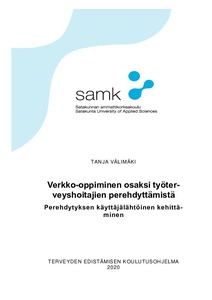Verkko-oppiminen osaksi työterveyshoitajien perehdytystä : Perehdytyksen käyttäjälähtöinen kehittäminen
Välimäki, Tanja (2020)
Välimäki, Tanja
2020
All rights reserved. This publication is copyrighted. You may download, display and print it for Your own personal use. Commercial use is prohibited.
Julkaisun pysyvä osoite on
https://urn.fi/URN:NBN:fi:amk-2020052814986
https://urn.fi/URN:NBN:fi:amk-2020052814986
Tiivistelmä
Opinnäytetyön tarkoituksena oli selvittää työterveyshoitajien näkemyksiä nykyisestä perehdyttämisestä sekä ajatuksia perehdyttämisen kehittämisestä tulevaisuudessa ja mallintaa työterveyshoitajien perehdytyksen käyttäjälähtöinen verkkokurssi toimeksiantajan verkko-oppimisympäristöön. Tavoitteena oli kehittää työterveyshoitajien perehdyttämistä yhtenäiseksi kokonaisuudeksi käyttäjäkokemukseen perustuen toimeksiantajan kaikissa toimipisteissä ympäri Suomea.
Opinnäytetyö toteutettiin kolmivaiheisena työelämälähtöisenä tutkimuksellisena kehittämistyönä, jossa lähestymistapana käytettiin palvelumuotoilua. Ensimmäisessä vaiheessa selvitettiin työterveyshoitajien näkemyksiä nykyisestä perehdyttämisestä, käytetyistä perehdytysmenetelmistä ja ajatuksia perehdyttämisen toteuttamisesta verkko-oppimisympäristössä. Kysely toteutettiin verkkokyselynä. Toisessa vaiheessa suunniteltiin perehdyttämisen verkkokurssin malli kyselyn tulosten, teoreettisen viitekehyksen ja toimeksiantajan perehdytysmateriaalin pohjalta. Kolmannessa vaiheessa järjestettiin verkkokurssin mallinnuksen arviointi yhdessä toimeksiantajan vapaaehtoisten työterveyshoitajien kanssa. Arvioinnissa käytettiin työkonferenssi- menetelmää.
Työterveyshoitajien mielestä nykyisen perehdytyksen hyviä asioita olivat vastaanotto ensimmäisinä työpäivinä, yksilöllisyys ja perehdytysmenetelmien käyttö, joista koettiin olleen hyötyä. Nimettyä perehdyttäjää arvostettiin, mutta sitä ei ollut kaikilla. Heikkoja ja kehitettäviä asioita olivat suunnitelmallisuus, yhteiset keskustelut esimiehen ja perehdyttäjän kanssa sekä riittävä resursointi ja aika. Verkossa tapahtuvaan perehdytykseen suhtauduttiin positiivisesti, kunhan aikaa on riittävästi ja lisäksi saa henkilökohtaista ohjausta. Vastaajien mielestä lähes kaikkia perehdytysaiheita voi opiskella verkkokurssilla.
Perehdytyksen verkkokurssin mallinnus koettiin selkeänä tapana toteuttaa työterveyshoitajien perehdytystä. Toimeksiantaja tulee hyödyntämään mallinnusta luodessaan työterveyshoitajan perehdytyksen verkkokurssin omaan verkko-oppimisympäristöönsä. The purpose of this study was to define occupational health nurses’ opinions on existing orientation methods, to research their thoughts of how to develop the orientation methods in the future, and model an online course for orientation with a user driven approach to the client’s web-learning environment. The aim of the study was to develop the orientation of occupational health nurses to an integrity that serves the users in all mandator’s offices around Finland.
The study was carried out as a service design based three-stage working life driven study and development work. First the nurses were asked their opinion on the existing orientation methods, and their thoughts on orientation in a web learning environment. An online survey was used. In the second stage a model of online course for orientation was planned on the base of the results of the survey, theoretical framework and the orientation material from the mandator. The third stage an evaluation of the online course model was organized together with voluntary occupational health nurses who work for the mandator. The evaluation was made with a democratic dialogue- method.
The results indicate that the welcome on the first days at work, individuality and the use of different orientation methods are being valued in the current orientation. A designated mentor was appreciated, but not always available. Orderliness, intercourse with the mentor and the superior and the sufficient resource and time were considered as insufficient. The occupational health nurses related positively on online course for orientation, as long as there is enough time and a personal mentoring is available. Based on the study almost every orientation theme can be studied in the web-learning environment.
The model of the web-learning environment was experienced as an explicit way to carry out the orientation of the occupational health nurses. The mandator will use the model to create an online course of orientation to the web-learning environment.
Opinnäytetyö toteutettiin kolmivaiheisena työelämälähtöisenä tutkimuksellisena kehittämistyönä, jossa lähestymistapana käytettiin palvelumuotoilua. Ensimmäisessä vaiheessa selvitettiin työterveyshoitajien näkemyksiä nykyisestä perehdyttämisestä, käytetyistä perehdytysmenetelmistä ja ajatuksia perehdyttämisen toteuttamisesta verkko-oppimisympäristössä. Kysely toteutettiin verkkokyselynä. Toisessa vaiheessa suunniteltiin perehdyttämisen verkkokurssin malli kyselyn tulosten, teoreettisen viitekehyksen ja toimeksiantajan perehdytysmateriaalin pohjalta. Kolmannessa vaiheessa järjestettiin verkkokurssin mallinnuksen arviointi yhdessä toimeksiantajan vapaaehtoisten työterveyshoitajien kanssa. Arvioinnissa käytettiin työkonferenssi- menetelmää.
Työterveyshoitajien mielestä nykyisen perehdytyksen hyviä asioita olivat vastaanotto ensimmäisinä työpäivinä, yksilöllisyys ja perehdytysmenetelmien käyttö, joista koettiin olleen hyötyä. Nimettyä perehdyttäjää arvostettiin, mutta sitä ei ollut kaikilla. Heikkoja ja kehitettäviä asioita olivat suunnitelmallisuus, yhteiset keskustelut esimiehen ja perehdyttäjän kanssa sekä riittävä resursointi ja aika. Verkossa tapahtuvaan perehdytykseen suhtauduttiin positiivisesti, kunhan aikaa on riittävästi ja lisäksi saa henkilökohtaista ohjausta. Vastaajien mielestä lähes kaikkia perehdytysaiheita voi opiskella verkkokurssilla.
Perehdytyksen verkkokurssin mallinnus koettiin selkeänä tapana toteuttaa työterveyshoitajien perehdytystä. Toimeksiantaja tulee hyödyntämään mallinnusta luodessaan työterveyshoitajan perehdytyksen verkkokurssin omaan verkko-oppimisympäristöönsä.
The study was carried out as a service design based three-stage working life driven study and development work. First the nurses were asked their opinion on the existing orientation methods, and their thoughts on orientation in a web learning environment. An online survey was used. In the second stage a model of online course for orientation was planned on the base of the results of the survey, theoretical framework and the orientation material from the mandator. The third stage an evaluation of the online course model was organized together with voluntary occupational health nurses who work for the mandator. The evaluation was made with a democratic dialogue- method.
The results indicate that the welcome on the first days at work, individuality and the use of different orientation methods are being valued in the current orientation. A designated mentor was appreciated, but not always available. Orderliness, intercourse with the mentor and the superior and the sufficient resource and time were considered as insufficient. The occupational health nurses related positively on online course for orientation, as long as there is enough time and a personal mentoring is available. Based on the study almost every orientation theme can be studied in the web-learning environment.
The model of the web-learning environment was experienced as an explicit way to carry out the orientation of the occupational health nurses. The mandator will use the model to create an online course of orientation to the web-learning environment.
